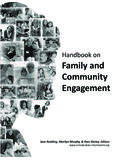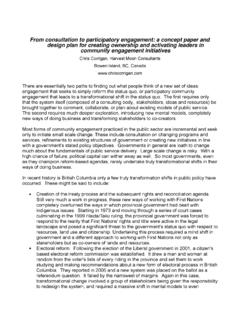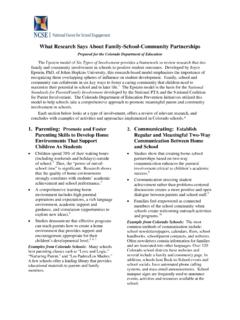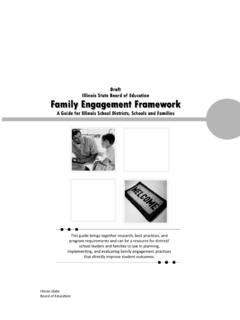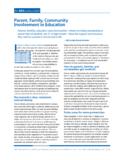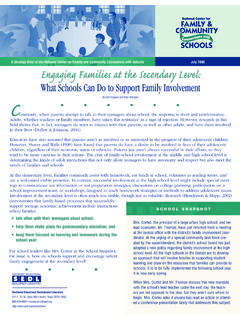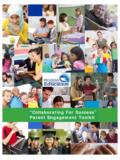Transcription of St. Lawrence County Head Start (SLCHS) Developmental ...
1 Revised 2014 Head Start Parent, family , & community engagement Framework strategies for Program progress Examples of progress family Well-Being: Parents and families are safe, healthy, and have increased financial security. Program Foundations Parents & Families: *Have considered benefits of participating in program services and/or activities. *Have developed relationships with staff that are helpful in supporting goals *Identify individual family strengths to cope with difficulties and overcome adversity. *Gain confidence to address specific needs and/or interests related to: Safety, housing stability, health and mental health, employments and job skills development and financial literacy.
2 Program Leadership *Ensure that systems, supports and resources are in place to address professional development, continuous improvement, program environment and partnerships related to family well-being. *Agency work plans are inclusive of goals related to family well-being. *Ensure staff members have appropriate training and supervision, as well as, manageable caseloads. *Relationships with community members and organizations that support families interests and needs are developed. Cross-service area teamwork is promoted. * A mental health consultant with appropriate credentials and experience is contracted to be a resources for staff and program needs around family well-being. Continuous Program Improvement *In order to understand community and family needs and interests the community assessment and self assessment surveys, the family partnership process, team meetings and other tools are used.
3 *Individual and system-wide family successes, helpful referrals and effective staff practices to evaluate services are reviewed. *Data is collected and aggregated for individual families so that program effectiveness can be determined. Professional Development *Develop knowledge of: cross-cultural responsiveness and strength based perspective in relationship building; supporting families around financial literacy and stability; professional ethics around confidentiality, boundaries and self-determination. *Gain Knowledge about: mental health, child development and a variety of parenting practices, including unique ways to engage fathers. *Develop skill in coordination and collaboration with community partners.
4 Program Impact Areas Program Environment *Welcome all family dynamics while building relationships which are receptive, responsive and respectful. *Engage in honest dialog with families regarding their expectations and staff/program objectives. family Partnerships *Use family partnership agreements as a tool for relationship building and ongoing individualized family services. *Help families identify their interests, articulate their strengths and needs and develop and/or accomplish goals through goal-oriented home visits. *Encourage families to continue using resources and systems of support. Teaching and Learning *Participate in cross-service area teams and program meetings to ensure that information about services related to family and child well-being can be supported by the curriculum.
5 community Partnerships *Effectiveness of support systems and resources that families have been linked to will be determined. *Participate in community meetings that increase ability to respond to the needs and interests of families. Child Outcome: Children are ready for school and sustain development and learning gains through third grade. St. Lawrence County Head Start (SLCHS) Developmental /School Readiness- Parent, family & community engagement Goals Revised 2014 Head Start Parent, family , & community engagement Framework strategies for Program progress Examples of progress Positive Parent-Child Relationships: Beginning with transitions to parenthood, parents and families develop warm relationships that nurture their child s learning and development.
6 Program Foundations Parents & Families: *Learned new ways to ensure health and safety of their child. *Gained knowledge of their children s social, emotional and cognitive development. *Learned new ways to understand and respond to their child s behavior. *Uses positive parenting practices which support their child s development. Program Leadership *Ensure that systems, supports and resources are in place to address professional development, continuous improvement, program environment and partnerships related to supporting positive parent-child relationships. *Agency work plans are inclusive of goals related to supporting positive parent-child relationships. *Ensure staff members have appropriate training and supervision, as well as, manageable caseloads to support families & their relationships with their infants, toddlers and preschool age children; Cross-service area teamwork is promoted.
7 Continuous Program Improvement *Use self assessments, surveys and ongoing conversations with families to build staff relationships with families and identify areas for improvement. *Use self assessments and surveys to understand participants parenting practices, and use this information to improve parenting education and supports. Professional Development *Gain knowledge about: Needs of parents who are parenting a child with a disability; Unique ways to engage fathers; How mental health and wellness affects families; Communication styles and relationship building; Child Development; Effect of parent-child relationships; A variety of parenting practices Program Impact Areas Program Environment *Hold the child and family in high regard and build positive relationships with all parent groups.
8 *Provide parent networking opportunities. *Support parent-child relationships in a way that values varying cultures and languages. family Partnerships *Support positive parent-child relationships in a manner that is both culturally receptive and responsive. *Help parents understand the stages of their developing child. *Support parents and families in ensuring the health and safety of their infants, toddlers and preschoolers. *Supports fathers efforts to connect with and be responsible for their children. *Support families in seeking support from mental health consultants or other community agencies to support parent-child relationships. *Foster positive parenting based on individual family dynamics.
9 Teaching and Learning *Acknowledge parents role as their child s first teacher while engaging with parents as equal partners in learning about their child. * Support positive parent-child relationships in a manner that is both culturally receptive and responsive. *Help families recognize their child s behaviors as an indicator of potential issues and/or concerns and identify strategies to overcome behavioral challenges. community Partnerships *Engage community partners to help support the needs of families who are parenting during stressful and challenging times. Child Outcome: Children are ready for school and sustain development and learning gains through third grade. Revised 2014 Head Start Parent, family , & community engagement Framework strategies for Program progress Examples of progress Families as Lifelong Educators: Parents and families observe, guide, promote and participate in the everyday learning of their children at home, school and in their communities.
10 Program Foundations Parents & Families: *Shared knowledge of their children with staff to guide teaching & learning. *Indentified their talents and strengths as parents and educators of their children, gaining confidence in the importance of their advocating for their child s lifelong learning goals. *Enjoyed and celebrated their child s learning and Developmental accomplishments. *Partnered with staff and used different approaches in the program, home and/or community that supported the essential learning outlined in the Head Start Child Development and Early Learning Framework. *Learned about options for acquiring services and supports for their child s learning, Developmental or behavioral challenges.
